Falling Between Stars: What About BSG‘s Starbuck?
Published on May 30th, 2011 in: Climb Onto The Nearest Star, Feminism, Issues, Science Fiction, TV |By Magda Underdown-DuBois
What is it about Kara “Starbuck” Thrace, played by Katee Sackhoff, which excites the fans of Battlestar Galactica (2003-2009) so much? Could it be her singular passion for the thrill of flight and fight? Perhaps it is her rebellion against authority. Or maybe it is something less clear and more ambiguous—her ability to step between expectations and limits and dance between the stars.
(more…)
Hey! Someone Got Romance In My Sci Fi!
Published on May 30th, 2011 in: Action Movies, Books, Climb Onto The Nearest Star, Feminism, Issues, Science and Technology, Science Fiction |By Lisa Anderson
For me, it all started with a gift bag.
An acquaintance of mine runs a paranormal romance* book club. Last year, she gave me a goody bag she had obtained, a reusable tote containing books, bookmarks, pencils, and other gifts. One of the ad fliers included had a starry background (indicating the book’s location in outer space) and featured a sexy embrace between a tough-looking woman in a black tank top . . . and a man wearing glasses.
It took my breath away. I couldn’t recall having ever seen a hero with glasses on the cover of a romance novel before. I’d been intrigued by the concept of Sci-Fi Romance (SFR), but had been burned by my first attempt, putting the book down after the third time the hero threatened the heroine’s life. I decided to give it another try, though, and bought the book from the flier—Rebels and Lovers, by Linnea Sinclair. Now SFR is my favorite romance subgenre!
(more…)
The Silver Metal Lover
Published on May 30th, 2011 in: Book Reviews, Books, Climb Onto The Nearest Star, Feminism, Issues, Science Fiction |Robots have frequently played pivotal roles in science fiction. In Fritz Lang’s Metropolis, the False Maria robot is created to destroy. Ridley Scott’s Blade Runner features several replicants, or biorobotic androids, created as human soldiers and slaves. There is Pris, the “basic pleasure model” and Zhora, an assassin. Both have a predetermined lifecycle of about three years. When the end approaches, both Pris and Zhora turn deadly. There is also Rachael, an even more advanced replicant, who does not even realize she is a replicant.
And then there is Tanith Lee’s 1981 novel, The Silver Metal Lover, which intriguingly combines elements of Metropolis, Blade Runner, and even Mary Shelley’s Frankenstein, to weave a spellbinding tale of the other part of the story: What happens when someone falls in love with a robot?
Scottish Sellout: KT Tunstall
Published on May 12th, 2011 in: Concert Reviews, Feminism, Music |By Christian Lipski
Photos by Deborah Lipski
Aladdin Theater, Portland OR
May 5, 2011
Portland’s Aladdin Theater was completely full, with people standing along the walls, pushing the boundaries of its 620-person capacity. The area in front of the stage was filled with chairs, but it was clear from looking at the audience that there wasn’t going to be any moshing anyway. A curious weighting on the older side for some reason, though the show was 21 and over due to alcohol sales. It’s possible that the people who grew up with the acoustic guitar-based singer-songrwiters of the ’70s find KT Tunstall‘s music to be familiar territory.
(more…)
The Mistress And The Maid: Mildred Pierce
Published on March 30th, 2011 in: Back Off Man I'm A Feminist, Books, Culture Shock, Feminism, Issues, Movies, Teh Sex, TV |By Less Lee Moore
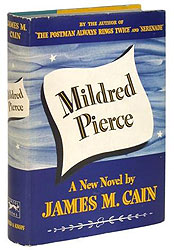
When I learned of the Mildred Pierce miniseries—directed by Todd Haynes and airing on HBO—I was thrilled. I’ve been a longtime fan of the novel and film, as well as of Haynes. Then I started to second-guess my excitement.
Would another male-directed version of this story merely intensify the story’s “male gaze”? Furthermore, should I revere Mildred Pierce as a feminist text when the original novel was written by one man (James M. Cain) and first captured on screen by another (Michael Curtiz)?
(more…)
Those Boots Aren’t Made For Walking: Wonder Woman Reimagined
Published on March 30th, 2011 in: Back Off Man I'm A Feminist, Comics, Feminism, Issues, TV |By AJ Wood
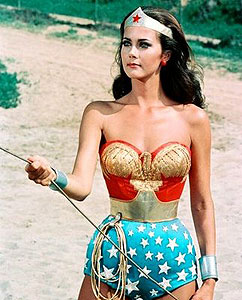
Lynda Carter as Wonder Woman
I remember little of my childhood, especially anything before age eight or nine, but one memory I do have from age four or five was Wonder Woman. Stripped down to my red and blue briefs and a red T-shirt tucked into them, with a lasso of kite string at my side, I felt wise as Athena, fast as Hermes, and stronger than Hercules. I had to imagine the boots, bracelets, and tiara, but the costume was close enough.
(more…)
The Women Behind The Whedonverse
Published on March 30th, 2011 in: Back Off Man I'm A Feminist, Feminism, Gaming, Horror, Issues, Magick, Movies, Science Fiction, The Internets, TV |By Lisa Anderson
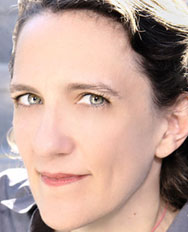
Even casual fans of Joss Whedon know that strong female characters are important to him. Buffy the Vampire Slayer, Echo from Dollhouse, and Zoe from Firefly are only a few examples. What casual fans may not realize is that women behind the scenes—Whedon’s fellow writers and producers—have also helped make his storylines beloved to so many fans. They include Jane Espenson, Marti Noxon, Maurissa Tancheroen, and Felicia Day.
(more…)
We Can Do It (Better): The Women Of The Mercury Program, The “Mercury 13”
Published on March 30th, 2011 in: Back Off Man I'm A Feminist, Feminism, Issues, Science and Technology |By Emily Carney
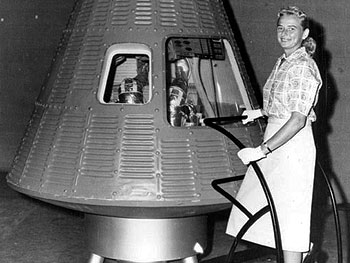
Jerrie Cobb, test pilot, stands next to a Mercury capsule.
I was born in 1978, and it is difficult for me to believe that in the late 1950s and early 1960s, the world was still rife with prejudices based on race, ethnicity, and gender. I joined the US Navy in 1997, and was sometimes exposed to painful instances of discrimination based upon my gender and general appearance. It is very upsetting to come to the realization that people may dislike you and prevent you from doing your job based on something you can’t change.
(more…)
“Seductive Subversion: Women In Pop Art”
Published on March 30th, 2011 in: Art, Back Off Man I'm A Feminist, Current Faves, Feminism, Issues |By Chelsea Spear
Exhibit at The Aidekman Center for the Arts
Medford, MA
Free association: When I say the words “Pop Art,” what comes to mind? Screen-prints of Brillo boxes and Campbell’s soup cans, Ben-Day dots on comic-strip women, cartoon collages. And pop artists? Andy Warhol, Roy Lichtenstein, Richard Hamilton, maybe Jasper Johns and Robert Rauschenberg. Like most art movements, Pop Art is considered to be a boys’ club. “Seductive Subversion” seeks to turn this misconception on its head.
(more…)
Beyond Twilight: Stephenie Meyer’s The Host
Published on March 30th, 2011 in: Back Off Man I'm A Feminist, Book Reviews, Books, Feminism, Issues, Movies, Science Fiction |By Lisa Anderson
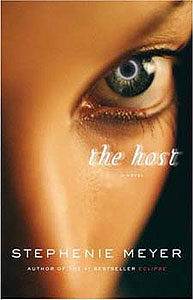
Stephenie Meyer: Few writers have ever had their work loved and hated so deeply at the same time.
Her Twilight series, consisting of four novels and a novella, has sold over 100 million copies worldwide and been translated into 38 languages, as well as being adapted into a film saga that is set to conclude this year. Meyer has a wide variety of critics, from vampire purists who resent the liberties she has taken with the lore, to feminists who find the relationship between her romantic leads unhealthy. In all the hubbub, though, you hear almost nothing about Meyer’s other brain child: A science fiction novel called The Host which was released in 2008.
(more…)
